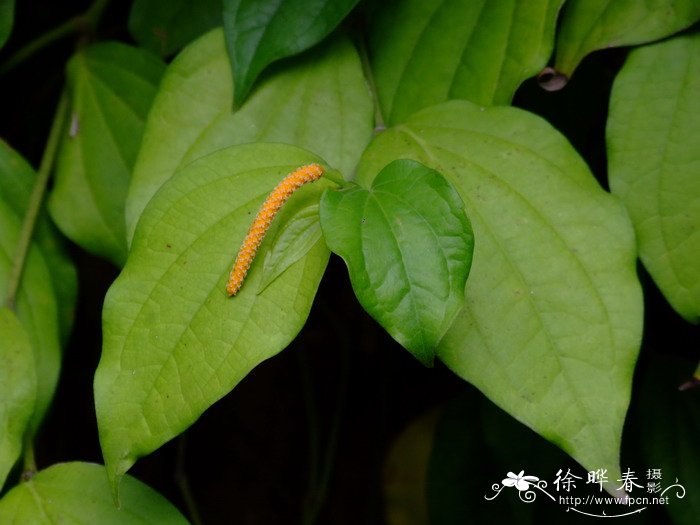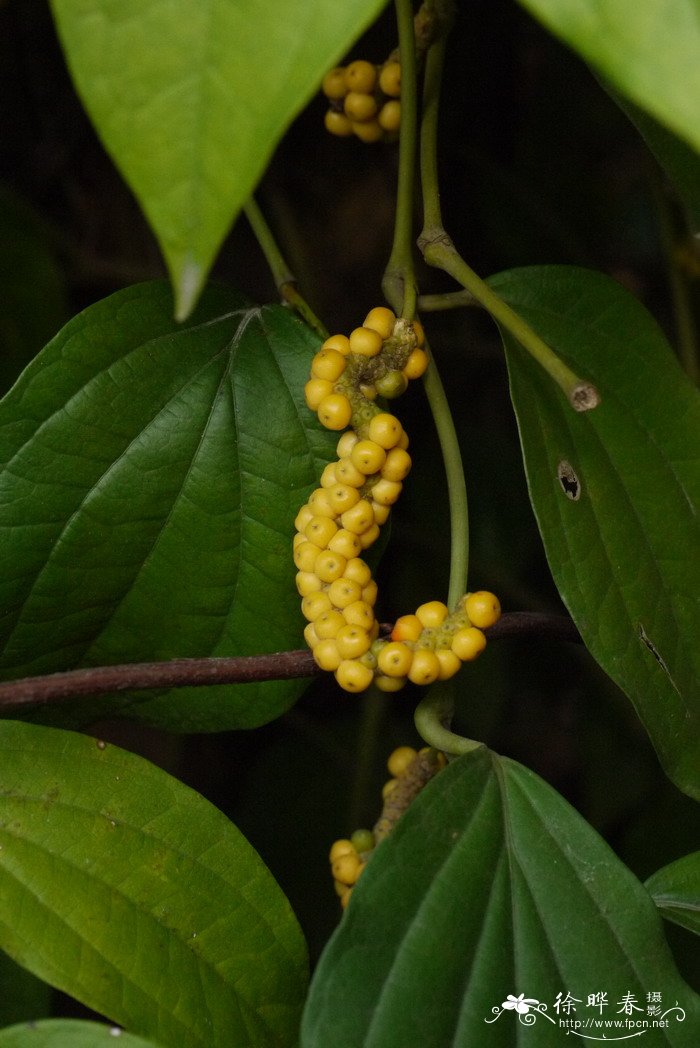山蒟Piper hancei
中文名(Chinese Name):山蒟
学名(Scientific Name):Piper hancei Maxim.
英文名(English Common Name):
别名(Chinese Common Name):
异名(Synonym):Chavica leptostachya Hance Piper matthewii Dunn
科属(Family & Genus):胡椒科(Piperaceae)胡椒属
形态特征(Description):攀援藤本,长数至10余米,除花序轴和苞片柄外,余均无毛;茎、枝具细纵纹, 节上生根。叶纸质或近革质,卵状披针形或椭圆形,少有披针形,长6-12厘米,宽2.5-4.5厘米,顶端短尖或渐尖,基部渐狭或楔形,有时钝,通常相等或有时略不等;叶脉5-7条,最上1对互生,离基1-3厘米从中脉发出,弯拱上升几达叶片顶部,如为7脉时,则最外1对细弱,网状脉通常明显;叶柄长5-12毫米;叶鞘长约为叶柄之半。花单性,雌雄异株,聚集成与叶对生的穗状花序。雄花序长6-10厘米,直径约2毫米;总花梗与叶柄等长或略长,花序轴被毛;苞片近圆形,直径约0.8毫米,近无柄或具短柄,盾状,向轴面和柄上被柔毛;雄蕊2枚,花丝短。雌花序长约3厘米,于果期延长;苞片与雄花序的相同,但柄略长;子房近球形,离生,柱头4或稀有3。浆果球形,黄色,直径2.5-3毫米。花期3-8月。
分布(Distribution):产于浙江、福建、江西、湖南、广东、广西、贵州及云南,生于山地溪涧边、密林或疏林中,攀援于树上或石上。
用途(Use):茎、叶药用,治风湿、咳嗽、感冒等。
引自中国植物志英文版:FOC Vol. 4 Page 127
Piper hancei Maximowicz, Bull. Acad. Imp. Sci. Saint-Pétersbourg. 31: 94. 1887.
山蒟 shan ju | Piperaceae | Piper
Chavica leptostachya Hance, J. Bot. 6: 301. 1868, not Piper leptostachyon Nuttall (1822); P. matthewii Dunn.
Climbers to more than 10 m, glabrous except for rachis and bases of bracts, dioecious. Stems rooting at nodes, finely striated. Petiole 5-12 mm; prophyll ca. 1/2 as long as petiole; leaf blade ovate-lanceolate or elliptic, rarely lanceolate, 6-12 × 2.5-4.5 cm, papery to ± leathery, base gradually tapered or cuneate, sometimes rounded, symmetric or nearly so, apex acute or acuminate; veins 5(-7), apical pair arising 1-3 cm above base, alternate, nearly reaching leaf apex; reticulate veins usually conspicuous. Spikes leaf-opposed. Male spikes yellow, 6-10 cm × ca. 2 mm; peduncle ca. as long as petioles or slightly longer; rachis pubescent; bracts suborbicular, ca. 0.8 mm wide, peltate, adaxially pilose, ± sessile to shortly stalked. Stamens 2. Female spikes ca. 3 cm, longer in fruit; bracts as in male spikes but petioles slightly longer. Ovary subglobose, distinct; stigmas (3 or )4. Drupe yellow, globose, 2.5-3 mm in diam. Fl. Mar-Aug.
* Forests, on trees or rocks; near sea level to 1700 m. Fujian, Guangdong, Guangxi, S Guizhou, S Hunan, SE Yunnan, Zhejiang
Used medicinally.



 (责任编辑:徐晔春)
(责任编辑:徐晔春)
学名(Scientific Name):Piper hancei Maxim.
英文名(English Common Name):
别名(Chinese Common Name):
异名(Synonym):Chavica leptostachya Hance Piper matthewii Dunn
科属(Family & Genus):胡椒科(Piperaceae)胡椒属
形态特征(Description):攀援藤本,长数至10余米,除花序轴和苞片柄外,余均无毛;茎、枝具细纵纹, 节上生根。叶纸质或近革质,卵状披针形或椭圆形,少有披针形,长6-12厘米,宽2.5-4.5厘米,顶端短尖或渐尖,基部渐狭或楔形,有时钝,通常相等或有时略不等;叶脉5-7条,最上1对互生,离基1-3厘米从中脉发出,弯拱上升几达叶片顶部,如为7脉时,则最外1对细弱,网状脉通常明显;叶柄长5-12毫米;叶鞘长约为叶柄之半。花单性,雌雄异株,聚集成与叶对生的穗状花序。雄花序长6-10厘米,直径约2毫米;总花梗与叶柄等长或略长,花序轴被毛;苞片近圆形,直径约0.8毫米,近无柄或具短柄,盾状,向轴面和柄上被柔毛;雄蕊2枚,花丝短。雌花序长约3厘米,于果期延长;苞片与雄花序的相同,但柄略长;子房近球形,离生,柱头4或稀有3。浆果球形,黄色,直径2.5-3毫米。花期3-8月。
分布(Distribution):产于浙江、福建、江西、湖南、广东、广西、贵州及云南,生于山地溪涧边、密林或疏林中,攀援于树上或石上。
用途(Use):茎、叶药用,治风湿、咳嗽、感冒等。
引自中国植物志英文版:FOC Vol. 4 Page 127
Piper hancei Maximowicz, Bull. Acad. Imp. Sci. Saint-Pétersbourg. 31: 94. 1887.
山蒟 shan ju | Piperaceae | Piper
Chavica leptostachya Hance, J. Bot. 6: 301. 1868, not Piper leptostachyon Nuttall (1822); P. matthewii Dunn.
Climbers to more than 10 m, glabrous except for rachis and bases of bracts, dioecious. Stems rooting at nodes, finely striated. Petiole 5-12 mm; prophyll ca. 1/2 as long as petiole; leaf blade ovate-lanceolate or elliptic, rarely lanceolate, 6-12 × 2.5-4.5 cm, papery to ± leathery, base gradually tapered or cuneate, sometimes rounded, symmetric or nearly so, apex acute or acuminate; veins 5(-7), apical pair arising 1-3 cm above base, alternate, nearly reaching leaf apex; reticulate veins usually conspicuous. Spikes leaf-opposed. Male spikes yellow, 6-10 cm × ca. 2 mm; peduncle ca. as long as petioles or slightly longer; rachis pubescent; bracts suborbicular, ca. 0.8 mm wide, peltate, adaxially pilose, ± sessile to shortly stalked. Stamens 2. Female spikes ca. 3 cm, longer in fruit; bracts as in male spikes but petioles slightly longer. Ovary subglobose, distinct; stigmas (3 or )4. Drupe yellow, globose, 2.5-3 mm in diam. Fl. Mar-Aug.
* Forests, on trees or rocks; near sea level to 1700 m. Fujian, Guangdong, Guangxi, S Guizhou, S Hunan, SE Yunnan, Zhejiang
Used medicinally.
踩一下[1]

顶一下[4]